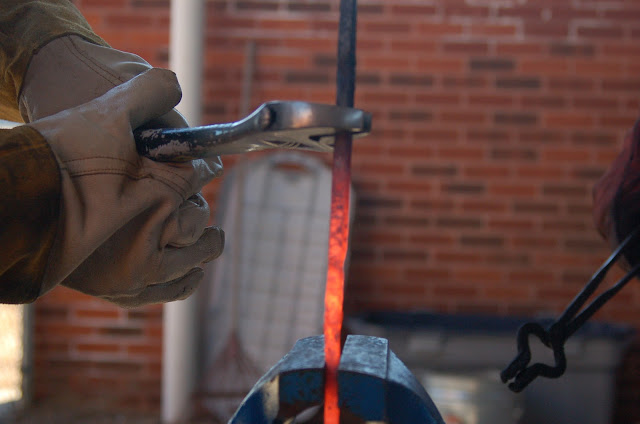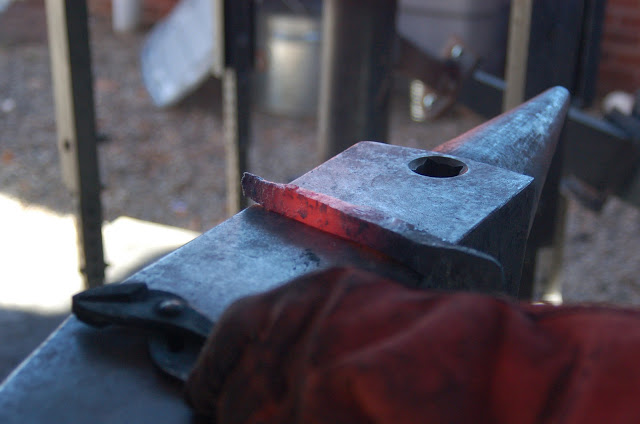Let me preface this entry with the fact that I have, for no known reason, had a miserable cough for the past 2 months. I don't smoke and I try to keep my allergies in check. I had a cold and the cough just seems to have stuck around. After two months though, it's starting to concern my mother, my housemates, and even me. Then I ran across this article while looking for thesis material and it kinda clicked in my head. This information is taken from http://www.moosecreekforge.com/hints.html.
COAL VERSUS CHARCOAL
WHY YOU MIGHT WANT TO CONSIDER USING WOOD CHARCOAL FOR YOUR NEXT FORGE FIRE
Most folks have the impression that blacksmiths have always used coal, and most blacksmiths have never used anything else, but consider the following.
Coal, more specifically bituminous or "soft" coal, has been used by blacksmiths in forge fires for hundreds of years... where and when it was available. But for a far longer period of history, especially in those areas where coal is not generally available, forge fires have been fueled with charcoal.
A Brief Historical Digression: It's been known for thousands of years that charcoal burns far more efficiently than raw wood - dried or not - and cook fires around the world have been fired by charcoal since fire, itself, was first used by humans. Since prehistoric times one of largest and most widespread trades was that of the charcoal burner. Charcoal burners were valuable members of any community, though generally existing at the very lowest social levels. Although there is a tremendous amount of skill and knowledge involved in the production of high quality charcoal - stacking the faggots of wood for optimal burning, control of oxygen during the burning process, precise burning time, and much more - it is an extremely dirty, tedious, solitary, low paying and generally undesirable job. Though their product was invaluable, charcoal burners were generally viewed as being at the lowest level of the menial labor force.
In light of this it is understandable that the fuel used for day-to-day cooking fires would also be used for forge fires as men discovered the various methods of shaping and working with metals. When coal was discovered it was found to produce a hotter fire than charcoal. As coal begins to burn, all of the various impurities (tars, oils, sulfur, various trace elements and gases, etc) are burned off, and all that remains is pure carbon. During this process smaller pieces of coal will clump or stick together in larger chunks. The product of this initial burning process was historically called "coal charcoal", but is more commonly known today as coke. This lightweight substance ignites rather easily, and burns hotly - with a forced-air draft it can reach temperatures approaching 4000 degrees Fahrenheit. It was also found that coal charcoal (coke) fires left unattended would die out rather quickly, leaving unconsumed fuel which could be used in subsequent fires. Coke lumps can be glowing on the underside, yet remain relatively cool on the top side. The topmost layer of coke on a forge fire acts as an insulator, holding in the heat from the fire beneath. In the immediate proximity of a coal-fired forge the air temperature is about 30 degrees Fahrenheit warmer than the ambient air temperature.
By contrast, when wood charcoal burns the individual pieces become completely ignited. Initially pieces of charcoal only burn on the side facing the center of the blaze, but eventually each piece will be completely ablaze. When left unattended, a wood charcoal fire will continue to burn until only ash remains. In a forge, unless new charcoal is constantly added, there is little in the way of insulation offered by the top most layer of charcoal on the fire. As a result a charcoal fire radiates a significantly greater amount of heat than a fire burning coal charcoal (coke). In the immediate proximity of a charcoal-fired forge the air temperature is about 45 degrees Fahrenheit warmer than the ambient air temperature. Additionally, wood charcoal burns slightly faster than coal charcoal (coke). Approximately 1/3 more wood charcoal is required than coke for equivalent forge activities. So, with all this in mind, it is obvious why coal charcoal, or coke, became the fuel of choice for blacksmiths.
But there are definite drawbacks to using coal, the least of which is that there are places where coal is unavailable, or too expensive to make its use feasible or profitable. Of more serious concern are the by-products of burning coal. During the coking process, burning coal gives off sulfur dioxide - a sulfurous gas combined with oxygen. When sulfur dioxide (SO2) combines with water (H2O) - including human sweat - it creates sulfuric acid (H2SO4). This acid can form on skin, causing skin irritation often referred to as a "forge rash". The acid can also form in the lungs, irritating the lining of the lungs and the bronchial tubes, causing the body to produce more mucus to protect the lining. The result is heavy coughing and congestion which can often lead to pneumonia (fluid build-up in the lungs). If clothing is damp with sweat the acid can form within the weave of the material, weakening it and often eating holes in the fabric. At the very least the acidic action reduces the usable life of the garment as it begins to disintegrate during repeated washings. Additionally, during the coking process, the tars and oils which burn off of the coal yield a thick, black smoke. Not only do deposits of the smoke in clothing make for more or less permanent stains, but this smoke can be extremely irritating to the eyes and lungs. There is so much oil and tar released in the smoke that metal held in the smoke will be coated with sufficient oil and tar to make it water and corrosion proof. The same coating process occurs in the nasal passages, the sinuses, and the bronchial tubes, resulting in a reduction of the sense of smell, and the blockage of bronchial membranes - making breathing more difficult as the lung's alveoli membranes are blocked from efficiently exchanging oxygen for carbon dioxide. The molten sulfur which does not oxidize in a coal fire will drip to the bottom of the fire, often mixing with particles of iron oxide from the forged iron, to produce a thick, heavy substance which can coat the firepot grating and stick to pieces of metal being worked. When cooled the substance hardens quickly into a metallic/ceramic compound referred to as "clinker" (due to the clinking sound made when struck by metal forge tools) or "cinder". For years this trash product was used to cover the surface of running tracks and as an inexpensive filler in the production of concrete building blocks. The jagged edges and sharp protrusions on pieces of clinker/cinder have resulted in its virtual elimination from running tracks (a fall on such a track can result in a serious injury), and building codes have all but eliminated cinder from the manufacturing process of concrete building materials. Clinker does not naturally decompose into lesser compounds and must be disposed of carefully to prevent contamination of ground water supplies.
Fires fueled by wood charcoal, on the other hand, burn cleanly, with little or no smoke. While resins in wood smoke make it an irritant to the eyes and lungs, there is little or no resin remaining in wood that has been turned into charcoal. The end product of a wood charcoal fire is wood ash - a readily biodegradable product which can be beneficial in agricultural applications. There is no oil or tar released by burning wood charcoal, thus bronchial problems as found with burning coal do not exist. Of course it is unhealthy to breath smoke of any kind, but there is almost no smoke present with a wood charcoal fire. Corrosion and water proofing of metals may be easily accomplished by wiping a thin coat of oil onto the metal, then subjecting the piece to low heat for a short period of time. The results are equal to that which may be accomplished using a coal fire. While the process of burning wood charcoal does release carbon monoxide into the air, most forging environments are sufficiently ventilated (drafty) to eliminate concern.
One last point in favor of wood charcoal is its renewable nature. Coal is a fossil fuel - there is a finite amount of it in the world, and as it becomes more scarce it will become more expensive. When it is gone there will be no more... ANYWHERE. Wood charcoal is a renewable resource. More wood may be grown to replace that which is converted for use as charcoal. Careful and judicious management of wood resources will result in a continuous supply of wood charcoal, without the danger that it will ever run out. Public awareness of the health concerns related to burning coal, as well as the public's generally awareness of the environmental drawbacks, is a product of relatively recent times. The use of coal as an inexpensive and reliable source of fuel has, for generations, overridden all other considerations, including the health of workers in coal-fired environments. Not only is it healthier to fire a forge with wood charcoal, it demonstrates a greater degree of responsibility for the environment and an awareness of the potential drawbacks of other fuels.
I switched from coal to wood charcoal over two years ago and have seen significant benefits to my personal health already. I no longer have a smoker's cough, my clothing cleans easier than before, and I use the wood ash by-product on my garden to increase the productivity of my agricultural pursuits. I urge everyone who forges with coal to seriously consider switching to hardwood charcoal as a fuel. Benefits from its use far outweigh any drawbacks. Of course there are those who will argue the point in favor of coal for traditional reasons, and I respect their point of view. But the tradition of wood charcoal is far older than that of coal. There are those, too, who will argue in favor of gas-fired forges, and they, too, have a valid argument. But natural gas, like coal, is a finite resource that will one day be exhausted. Don't make the switch simply because I suggest it. Make an informed decision based on all of the information available. Consider the information provided here, perhaps even burn a bag or two of wood charcoal in your forge, then take whatever action you personally deem most appropriate.
Happy Forging - Steve "Tiny" Robinson




































































